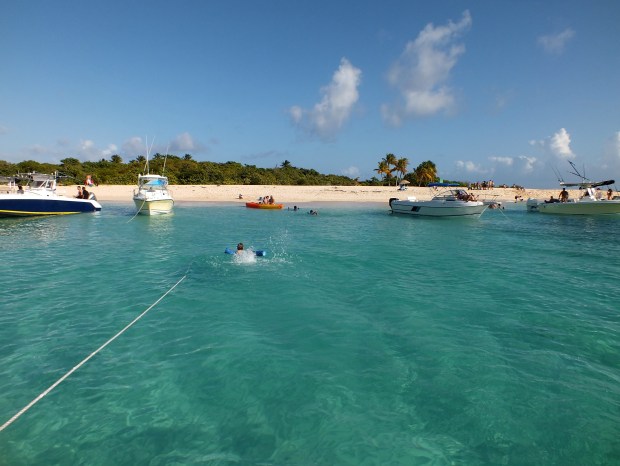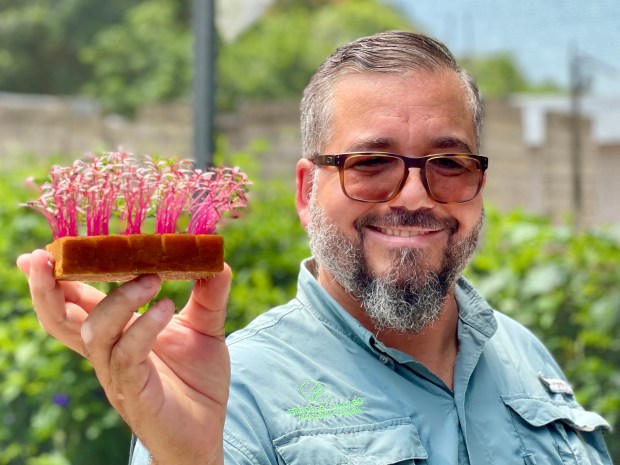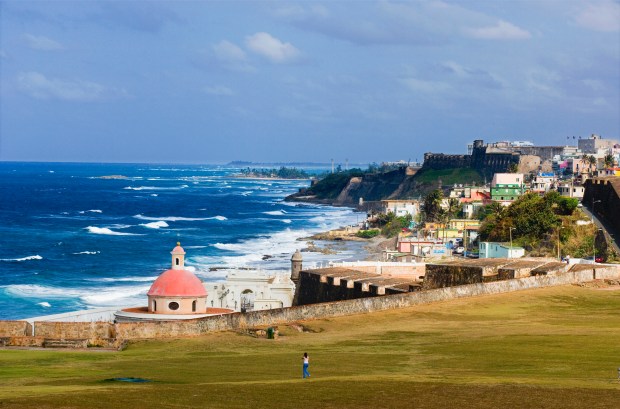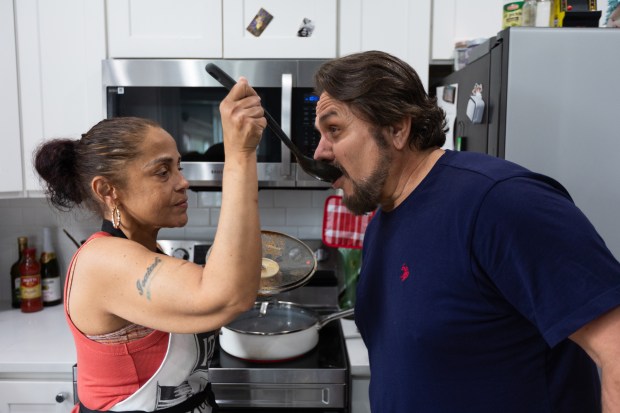It’s well past sunset in Puerto Rico’s La Parguera Bay and the water beneath our boat is as dark as the night sky above. That makes me a bit nervous. But then the light show begins, and all caution is gone.
Down the ladder I go into the warm waters of the Caribbean. As my pals who climbed in before me discovered, the water comes alive with sparks when you kick your legs or push your arms through the dark beneath the surface.
We are in one of Puerto Rico’s three bioluminescent bays, where microscopic organisms called dinoflagellates produce sparks of light when they are agitated. La Parguera, in Puerto Rico’s southwest corner, is the only one of the three to allow swimming. I’ve dreamed of swimming with what I think of as underwater lightning bugs, and actually doing it is thrilling.
With stars overhead, I floated through the water, marveling at my good fortune. It seemed as if I were conducting an underwater symphony of fireworks as I drifted around the boat. Or working on a museum masterpiece with light following my hands, almost like color from a paintbrush, as I twirled in a circle, then chasing my kicking feet as I floated on my back. It was hard to suppress a giggle.
Diamonds, glitter, fireworks are all things that grab your attention, and they’re apt comparisons for the activity of these microorganisms. Even understanding the science behind bioluminescence, there is mystery and wonder in the experience.
Floating in the warm waters as the bugs lit up was joyous and humbling and transformational in a way that made me feel connected to the world and its mysteries. I was a minuscule part of the wonders of the universe, almost as if I were dancing with these tiny life forms.
Marine bioluminescence has been seen in other parts of the world, but three of the five most well-known bio bays are the ones in Puerto Rico.
Mosquito Bay, recognized as the brightest bio bay in the world, is on the island of Vieques, reachable by a short flight or a 45-minute ferry boat ride. The bay has little light pollution and is in a remote natural setting. Visitors can get up close to the glowing plankton in kayaks, some with glass bottoms, offering a better view.
The most visited bio bay in Puerto Rico is Laguna Grande, just a little more than an hour’s drive from the capital of San Juan. Like at Mosquito Bay, tour operators offer multiple time slots per night for kayak outings.
“Our island’s diverse ecosystem offers endless opportunities for outdoor adventures, and the three bio bays — Mosquito Bay, Laguna Grande and La Parguera — are among the top attractions,” said Leah Chandler, chief marketing officer at Discover Puerto Rico. “What makes them truly unique is their year-round bioluminescence, unlike other places where this phenomenon is seasonal. This means visitors can experience the magic of our glowing bays any time of the year.”
La Parguera is the only bio bay in Puerto Rico that currently allows swimming. That’s because its natural formation and the way it connects to the ocean allow for water exchange that helps flush out potentially harmful chemicals left behind by swimmers.
“The decision to restrict swimming in other bio bays is indeed a sustainability measure, aimed at preserving the delicate ecosystems and ensuring that these natural wonders can be enjoyed for generations to come,” Chandler said.
If you’re planning a trip to a bio bay in Puerto Rico, schedule it on nights near a new moon when there’s less light in the sky. Taking a tour later in the evening, when the sky will be darker than just after sunset, will make the sparks appear brighter. But a sunset tour has its benefits as well.

The boat trip I took with Paradise Scuba last year started with a stop to watch the sunset while the group dined on empanadas and cold drinks. After we finished eating and drinking, the captain headed farther into the bay as the sky darkened. That’s when the real fun began.
Paradise Scuba says its $95 sunset snorkeling and bio bay excursion is its most popular tour.
For me, the nighttime swim in La Parguera Bay was a highlight of my trip to Puerto Rico. I’m not alone. Puerto Rico tourism officials say the bays attract visitors from around the world.
But there’s a lot more that draws travelers to this Caribbean island that is a U.S. territory. For Americans, it’s easy to get to and from the U.S. mainland, and some of the hassles of travel are eased with no need for a passport or exchanging money. For those who might not know, the U.S. dollar is the official currency.

The island’s attractions include myriad outdoor activities such as surfing, fishing, paddleboarding, caving, horseback riding, birdwatching and riding one of the longest zip lines in the Americas, the 1.57-mile-long El Monstro in the mountainous Orocovis region in central Puerto Rico.
There are miles of beaches. And then there’s El Yunque National Forest, the only tropical rainforest in the U.S. Forest Service system. Hiking trails, rivers, waterfalls and swimming holes are front and center. It’s near enough to San Juan to make it an easy day trip from the city.
Beyond Puerto Rico’s natural wonders and outdoor activities, there are big-city attractions in San Juan, where history and fine dining set the tone. Spend the day in Old San Juan, wandering streets lined with historic monuments and pastel-colored buildings dating to the time when the island was ruled by the Spanish.

Or head out into the rural areas for agritourism activities at a place like Frutos del Guacabo, where you can milk goats and visit the gardens or the hydroponic greenhouse before dining outdoors in a truly farm-to-table experience.
And then there’s the rum.
Said to be the national drink, the fruity pina colada rum cocktail was invented in Puerto Rico some 70 years ago, but there’s some dispute over who exactly concocted the drink. What’s undisputed, though, is that the local Casa Bacardi is one of the top-selling rums in the world, producing about 21 million cases of the clear spirit annually. Bacardi is one of the island’s three main distilleries, all of which offer tours and tastings.
There’s much to keep all kinds of travelers entertained in Puerto Rico. But if you’re anything like me, you’ll always remember your time spent at a bio bay, like seeing a bit of the Milky Way underwater.
Terri Colby is a freelancer.





